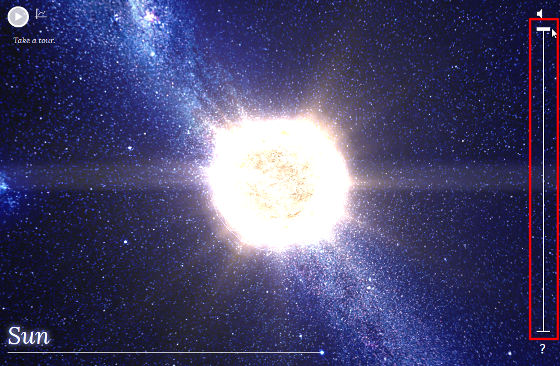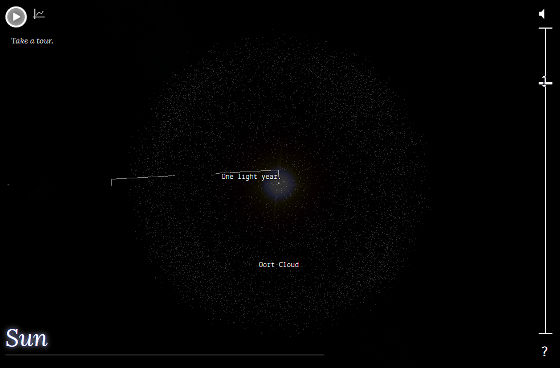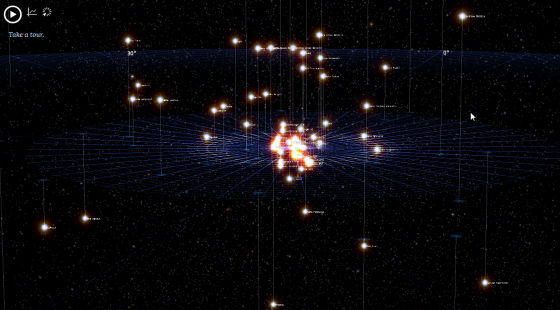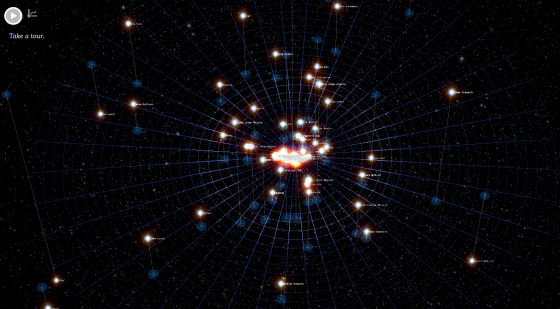"100,000 Stars" that you can feel the universe by moving the galaxy

You can display the Milky Way in the room "Pinhole type planetariumIf you have, you can easily enjoy the starry sky at home, but the sense of scale you feel when you actually look up at the night sky and feel the sky full of stars is another thing. "100,000 Stars" that can reproduce the scale of such universe on a personal computer and move freely is released.
100,000 Stars
http://workshop.chromeexperiments.com/stars
Here is a movie that introduced this "100,000 Stars" in an easy-to-understand manner.
100,000 Stars - YouTube
The sun that is the center of our solar system

It takes 18 years to fly from the earth to the sun on a jet plane.

As an artifact flying to the furthest place from the earthI escaped the solar system for the first time"Voyager 1"Is currently flying 17 hours in speed from the earth.

Illustrated is "1 light-year" which is the distance the light travels in a year, converting it to 9.46 trillion kilometers.

As we moved farther and farther from the solar system, we saw nearby stars. Still, nearestCentaurus seat Alpha starUntil there are 3.9 light years distance.

In this 100,000 Stars, research by astronomers has been done so far and the stars given the name are displayed.

On this screen, a collection of more than 100,000 stars is represented.

Gradually, the appearance of the Milky Way has come to light.

This is the whole view of the "Milky Way Galaxy" to which we belong. It has 200 billion to 400 billion stars and its diameter is a tremendous size of over 100,000 light years. It is exactly "astronomical" size.

And the screen bounces between the stars ... ...

I came back to the sun. From here you can move the screen using the mouse yourself.

Let's actually move it. You can zoom with the mouse wheel or the slider on the right side of the screen.

As I slid down the slider, the figure of the solar system came into sight. It is a revolution orbit to our earth and Mars.

As we go further away, the orbit of Neptune has come into view. Now that Pluto has been downgraded to "dwarf planet", this is the whole picture of the solar system.

And gradually, "Oult CloudI came to see it. It is a celestial group mainly composed of ice and exists in a wide area one light-years away from the sun.

As we move further away, we can see a number of stars in the vicinity of the solar system.

The star system closest to the earth "Centaurus seat Alpha star"Click on the mouse and ......

A description of the star was displayed. It seems to be an excerpt from Wikipedia.

Click the arrow icon above the description to close the description window and return to the original screen.

As we moved further and farther away, the screen displayed a blue grid representing the planes of revolution of the earth. The intersection point with the line vertically lowered from each planet is displayed on the grid surface, making it easy to grasp the three-dimensional positional relationship.

Next time we will change the angle and look at the revolving surface from above (from the north).

As it steadily goes north, the center of the north side of the revolving surfaceHeavenly Arctic) "Polaris" located in the so-calledPolarisI came to see it.

Click on the name to display the details, and look a little apart like this. Polaris is generally called "Polaris Star", but in realityPolaris AWhenPolaris BBecause of the binary series consisting of, the screen display looks like this. There is a distance of 2700 astronomical units between the two objects, so the actual appearance should be different.

Also, when you click the icon on the graph on the upper left of the screen ... ...

Switch to the indication of star temperature. Each point is used to represent the temperature of the starColor temperatureIt shows.

Looking at this way, you can see that there are a huge number of stars in the universe.

As we move further away, the stars we have been looking at are hidden in the clouds of larger stars ... ...

A huge galaxy appeared. I think that the earth we live in is much smaller than the one dot of the display we are looking at, and I feel that I can understand the size of the universe only a little.

"100,000 Stars" taught the scale of the universe thus gathered an experimental web project by creatorsChromeExperimentsIt was published in. We used data for NASA (American Aeronautics and Space Administration) and ESA (European Space Agency) for creating maps, and it seems that the shortest one is used for the star whose distance to the sun is changing.
Workshop / Chrome Experiments
http://workshop.chromeexperiments.com/
It is more convenient if it can search by the name of the star because it is too wide to display and it is difficult to find the star, but it seems that you can feel the extent of the universe as it is hard to find a star.
Related Posts:
in Note, Web Service, Posted by darkhorse_log






